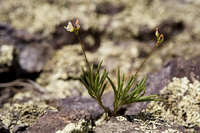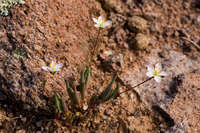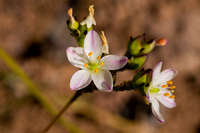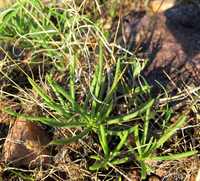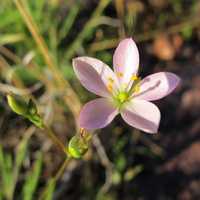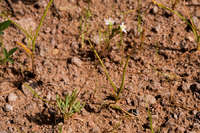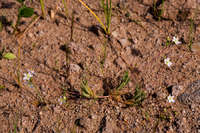Plants to 2 dm; roots elongate, fleshily woody. Stems ± erect, simple or branching, sometimes suffrutescent. Leaves sessile; blade terete, sometimes slightly broadened at base, to 5 cm. Inflorescences cymose, much overtopping leaves; peduncle scapelike, to 15 cm. Flowers usually pedicellate, sometimes sessile or subsessile; sepals deciduous or sometimes persistent, ovate, to 4.5 mm, apex sometimes purplish, acuminate-cornate, thickened; petals light pink to purplish, elliptic to obovate, to 7 mm; stamens (4-)5(-6); stigma 1, subcapitate, sometimes stigmas 3-lobed, or 3, triangular. Capsules ellipsoid or sometimes ovoid, sometimes obtusely trigonous, 3-5 mm. Seeds without arcuate ridges, 0.8-1 mm. 2n = 24, 48.
Flowering Apr-Sep. Dry woodland, grassland, chaparral, scrub, canyon washes, mountain slopes and ledges, sandy, usually rocky soil, outcrops; 0-2700 m; Ala., Ariz., Ark., Colo., Ill., Iowa, Kans., La., Minn., Mo., Nebr., N.Mex., N.Dak., Okla., S.Dak., Tex., Utah, Wyo.; n Mexico (Chihuahua, Coahuila).
Over its extensive range, Phemeranthus parviflorus varies considerably in several characters, including overall size. Although this variation is more or less continuous, correlating very generally with habitat type and geographic location, some populations that are found toward the limits of the species´ range and that exhibit combinations of tendencies to extremes in the variable characters have been recognized separately. The Alabama populations, few and confined to a very small area on gneiss in the central part of the state, disjunct from the main trans-Mississippi distribution of P. parviflorus, with elongate stems, small flowers, and stigmas often three-lobed, or three instead of one, have been described as Talinum appalachianum. Plants from Arizona with stems slender and tending to elongate, sepals acuminate-cornate and usually purplish, and capsules ovoid have been described as T. gooddingii. Plants from the mountains of New Mexico with elongate stems, subsessile flowers, markedly congested cymes, and acuminate, often persistent sepals have been described as T. confertiflorum (P. confertiflorus).
PLANT: Herbs to 2 dm tall.
ROOTS: elongate, becoming stout, somewhat woody.
STEMS: simple or branching, more or less erect, sometimes suffrutescent.
LEAVES: usually congested, sessile, terete, to 5 cm long.
INFLORESCENCE: lateral or terminal cymes, erect, greatly overtopping the leaves; peduncles scape-like.
FLOWERS: sepals ovate, sometimes acuminate-cornate, 2.5-4.5 mm long, deciduous or sometimes persistent beyond capsule dehiscence and slightly shorter than mature capsule; petals obovate to elliptic, 5-7 mm long, pink to purple; stamens (4-)5(-6); stigma 1, subcapitate.
CAPSULES: ellipsoid or sometimes ovoid, sometimes obtusely triquetrous, 3.5-5 mm long.
SEEDS: smooth, ca. 1 mm long.
NOTES: Dry woodlands, chaparral, scrub and grassland, on outcrops and in rocky soil; all counties except Graham, La Paz, Maricopa, Pinal, Yuma; 1200-2400 m (4000-7800 ft); Jun-Sep; AL, & MN, w to NM & WY; Chih., Coah., Mex. Varying considerable over its wide range. Plants from AZ with stems slender and tending to elongate, sepals apically cornate, and capsules ovoid have been recognized as T. gooddingii but intermediates of all degrees are found.
REFERENCES: Allison Bair, Marissa Howe, Daniela Roth, Robin Taylor, Tina Ayers, and Robert W. Kiger., 2006, Vascular Plants of Arizona: Portulacaceae. CANOTIA 2(1): 1-22.
Duration: Perennial
Nativity: Native
Lifeform: Forb/Herb
General: Perennial herb, up to 20 cm tall, from elongate, fleshy roots which can become stout and woody with age; stems erect to ascending, simple or branched, and sometimes becoming suffretescent (slightly woody).
Leaves: Sessile and mostly clustered near the base of the stem; blades fleshy and terete (round in cross section), up to 5 cm long and 2 mm wide.
Flowers: Pale pink to purple, arranged in few-flowered clusters or cymes which are held well above the leaves on a slender leafless stalk up to 15 cm tall; sepals 2 per flower, ovate, 3-4 mm long, and usually deciduous before the seed capsules mature; petals 5 per flower, obovate to elliptic, 5-7 mm long, usually light pink to purplish, but flower color can range from white to magenta.
Fruits: Capsules 3-5 mm long, ellipsoid or ovoid, 3-chambered; splitting open longitudinally from the apex to release many tiny seeds, each about 1 mm long.
Ecology: Found in shrublands, woodlands, and chaparral, on outcrops or in rocky soil, from 4,000-8,000 ft (1219-2438 m); flowers June-September.
Distribution: WY to MN, south to AZ, NM, TX, LA, and AL; south to n MEX.
Notes: This small perennial is distinctive with its basal tuft of succulent, terete leaves, and delicate pink flowers held above the leaves on a slender scape. The flowers are only open for a few hours in the afternoon. The species has a fairly large range across central and western North America and is somewhat variable across its range, especially in plant height, sepal shape, and pedicel length. FNA (2003) lumps P. confertiflorus into P. parviflorus, and the above description follows that treatment. Allred and Ivey (2012) and Bair et al. (2006; Vascular Plants of Arizona Project) also follow FNA, but Heil et al. (2013) consider P. confertfilorus to be a separate taxon, with sepals that persist on the plant as the seed pods mature and split open, and narrower seed pods. This taxon can be challenging to locate in older texts; the genus Phemeranthus was recently split out from the tropical genus Talinum, and both these genera were formerly placed in Portulacaceae.
Ethnobotany: A poultice of the root bark was applied to sores; an infusion of the root bark was used as lotion.
Etymology: Phemeranthus comes from Greek ephemoros, living for one day, and anthos, flower; parviflorus means small-flowered.
Synonyms: Talinum parviflorum, Talinum gooddingii, Talinum confertiflorum, Tallinum appalachianum, Talinum fallax, Talinum gracile, Talinum rosei
Editor: SBuckley 2010, AHazelton 2017
Infl 8-15 cm; pet 4-7 mm, pale or dull pink; stamens 4-8, commonly 5 or 6, stigma capitate; fr 3-6 mm; 2n=24, 48. Thin, acidic soil overlying rocks; Minn. (and reputedly sw. Wis.) to S.D. and Colo., s. and w. to Ark., Tex., and Ariz.; disjunct in c. Ala. June, July. Fls open from noon to late afternoon.
Gleason, Henry A. & Cronquist, Arthur J. 1991. Manual of vascular plants of northeastern United States and adjacent Canada. lxxv + 910 pp.
©The New York Botanical Garden. All rights reserved. Used by permission.



